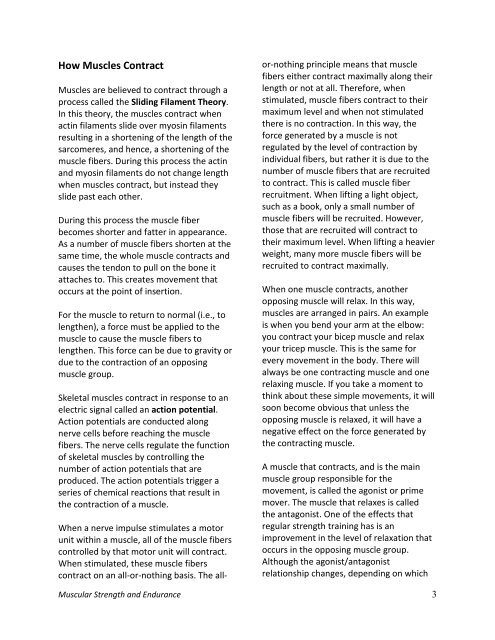Concepts of Fitness and Wellness 2e, 2018
Concepts of Fitness and Wellness 2e, 2018
Concepts of Fitness and Wellness 2e, 2018
Create successful ePaper yourself
Turn your PDF publications into a flip-book with our unique Google optimized e-Paper software.
How Muscles Contract<br />
Muscles are believed to contract through a<br />
process called the Sliding Filament Theory.<br />
In this theory, the muscles contract when<br />
actin filaments slide over myosin filaments<br />
resulting in a shortening <strong>of</strong> the length <strong>of</strong> the<br />
sarcomeres, <strong>and</strong> hence, a shortening <strong>of</strong> the<br />
muscle fibers. During this process the actin<br />
<strong>and</strong> myosin filaments do not change length<br />
when muscles contract, but instead they<br />
slide past each other.<br />
During this process the muscle fiber<br />
becomes shorter <strong>and</strong> fatter in appearance.<br />
As a number <strong>of</strong> muscle fibers shorten at the<br />
same time, the whole muscle contracts <strong>and</strong><br />
causes the tendon to pull on the bone it<br />
attaches to. This creates movement that<br />
occurs at the point <strong>of</strong> insertion.<br />
For the muscle to return to normal (i.e., to<br />
lengthen), a force must be applied to the<br />
muscle to cause the muscle fibers to<br />
lengthen. This force can be due to gravity or<br />
due to the contraction <strong>of</strong> an opposing<br />
muscle group.<br />
Skeletal muscles contract in response to an<br />
electric signal called an action potential.<br />
Action potentials are conducted along<br />
nerve cells before reaching the muscle<br />
fibers. The nerve cells regulate the function<br />
<strong>of</strong> skeletal muscles by controlling the<br />
number <strong>of</strong> action potentials that are<br />
produced. The action potentials trigger a<br />
series <strong>of</strong> chemical reactions that result in<br />
the contraction <strong>of</strong> a muscle.<br />
When a nerve impulse stimulates a motor<br />
unit within a muscle, all <strong>of</strong> the muscle fibers<br />
controlled by that motor unit will contract.<br />
When stimulated, these muscle fibers<br />
contract on an all-or-nothing basis. The allor-nothing<br />
principle means that muscle<br />
fibers either contract maximally along their<br />
length or not at all. Therefore, when<br />
stimulated, muscle fibers contract to their<br />
maximum level <strong>and</strong> when not stimulated<br />
there is no contraction. In this way, the<br />
force generated by a muscle is not<br />
regulated by the level <strong>of</strong> contraction by<br />
individual fibers, but rather it is due to the<br />
number <strong>of</strong> muscle fibers that are recruited<br />
to contract. This is called muscle fiber<br />
recruitment. When lifting a light object,<br />
such as a book, only a small number <strong>of</strong><br />
muscle fibers will be recruited. However,<br />
those that are recruited will contract to<br />
their maximum level. When lifting a heavier<br />
weight, many more muscle fibers will be<br />
recruited to contract maximally.<br />
When one muscle contracts, another<br />
opposing muscle will relax. In this way,<br />
muscles are arranged in pairs. An example<br />
is when you bend your arm at the elbow:<br />
you contract your bicep muscle <strong>and</strong> relax<br />
your tricep muscle. This is the same for<br />
every movement in the body. There will<br />
always be one contracting muscle <strong>and</strong> one<br />
relaxing muscle. If you take a moment to<br />
think about these simple movements, it will<br />
soon become obvious that unless the<br />
opposing muscle is relaxed, it will have a<br />
negative effect on the force generated by<br />
the contracting muscle.<br />
A muscle that contracts, <strong>and</strong> is the main<br />
muscle group responsible for the<br />
movement, is called the agonist or prime<br />
mover. The muscle that relaxes is called<br />
the antagonist. One <strong>of</strong> the effects that<br />
regular strength training has is an<br />
improvement in the level <strong>of</strong> relaxation that<br />
occurs in the opposing muscle group.<br />
Although the agonist/antagonist<br />
relationship changes, depending on which<br />
Muscular Strength <strong>and</strong> Endurance 3


















